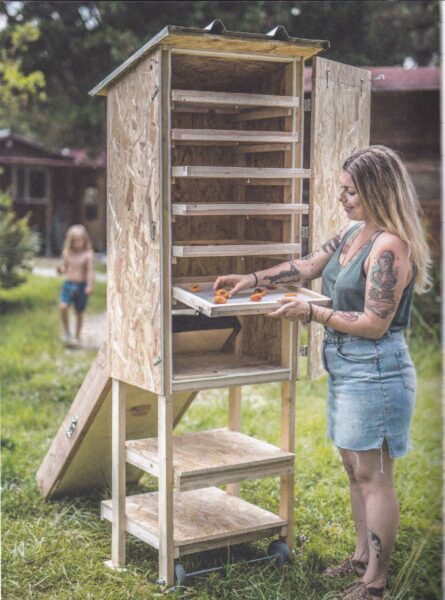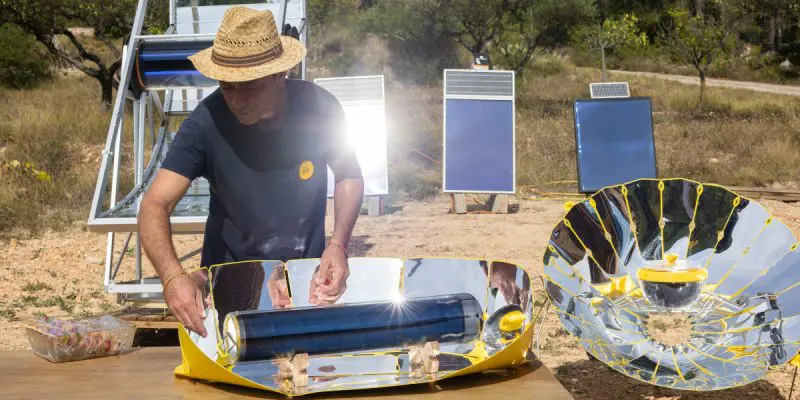News
All you need to know about solar dryers
All you need to know about solar dryers
In this article, we review all aspects of natural food dehydration with a solar dryer: the different drying methods – how solar dryers work – the benefits of solar dehydration. Enjoy your reading!
Traditional air-drying of foodstuffs
The traditional method for drying foodstuffs is to place them in the sun, in the open air. This method, known as natural drying or air drying, is effective for small quantities of food. The surface area required for drying in the sun increases with the quantity of food, and as food is placed in the open air, it is easily contaminated. Consequently, one of the main reasons why sun-drying is not easy to achieve with larger quantities of food is that control and monitoring become increasingly difficult as food quantities increase.
How does the solar dryer work?
Unlike sun-drying, where food is exposed directly to the sun, the solar drying method uses indirect solar radiation. The principle of solar drying technology is to collect solar energy by heating the air volume in solar collectors, and to conduct the hot air from the collector to the drying chamber. This is where the products to be dried are placed.

In this closed system, consisting of a solar collector and a drying chamber, with no direct exposure of the meat to the environment, meat drying is more hygienic, as there is no secondary contamination of the products by rain, dust, insects, rodents or birds. Products are dried using only hot air. There is no direct impact of solar radiation on the product. Solar energy produces hot air in solar collectors. Increasing the temperature in a given volume of air decreases the air’s relative humidity and increases its capacity to absorb water. A steady flow of hot air in the drying chamber, circulating through and over the pieces of meat, ensures continuous, efficient dehydration.
What is the capacity of a solar dryer?
The solar dryer or solar dehydrator is a relatively simple concept. An important feature of drying systems is the size of the solar collectors. Depending on the quantity of product to be dried, the collectors must be able to supply sufficient quantities of hot air to the drying chamber. Collectors too small for the quantity of food to be dried will result in failed attempts and food spoilage.
What is the drying process?
The food drying process consists of 3 stages:
1. Converting light into heat: the presence of black inside a solar dryer improves the efficiency of light-to-heat conversion.
2. Heat trapping: insulating the air inside the dryer from the outside air makes an important difference. Using a transparent solid, such as a plastic bag or glass lid, allows light to enter, but once the light is absorbed and converted into heat, the plastic bag or glass lid traps the heat inside to dehydrate the food. This makes it possible to achieve similar temperatures in cold, windy weather as in hot.
3. Moving heat to the food: Both the natural convection dryer and the forced convection dryer use heated air convection to move heat to the food. When the heat is redirected into the hot chamber, the humidity in the air is drastically reduced, enabling dehumidification and drying of fruit, for example.
The 3 types of solar dryer
A wide variety of solar dryer models are available. Essentially, solar dryers can be divided into three groups:
1. Natural convection solar dryer
Solar dryers use the natural vertical convection that occurs when air is heated. In general, natural convection dryers are the right size for farm use.
The structure consists of three main elements: a solar collector, a drying tank and a solar chimney. Smaller, natural convection dryers are essentially wooden boxes with top and bottom vents. Food is placed on wire mesh frames that slide into the boxes. An appropriately sized solar air heater, with south-facing plastic glazing and a black metal absorber, is connected to the bottom of the boxes. Air enters at the bottom of the solar air heater and is heated by the black metal absorber. Hot air rises along the food and exits through vents at the top.
In operation, these dryers produce temperatures of 54 to 82°C, which is desirable for most food drying and pasteurization processes. With these dryers, food can be dried in a single day, even when the weather is partly cloudy, misty and very humid. Inside, there are thirteen shelves that hold 35 to 40 medium-sized apples or peaches, cut into thin slices.
2. Forced convection solar dryer
Convection is forced onto the food using a fan. In the case of forced convection dryers, the structure can be relatively similar. However, the forced convection dryer requires a power source for the fans to provide the airflow. The forced convection dryer does not require an incline for the air flow, but the collector can be placed horizontally with the fan at one end and the drying tray at the other.
In addition, the forced convection dryer is less dependent on solar energy, as it provides the airflow itself; this enables the design to operate in weather conditions in which the natural convection dryer does not function. Since inadequate ventilation is one of the main causes of food loss in solar dryers, and is exacerbated by intermittent heating, proper ventilation is essential. The addition of a forced convection flow, for example provided by a PV solar cell connected to a fan, will prevent food loss.
3. Solar tunnel dryer
The structure of a tunnel dryer is relatively simple, with a polyethylene wall that is particularly resistant to high temperatures. Unlike other types of dryer, the structure is large enough for one person to fit inside.
How to dry food properly
Drying is an important stage in the food production process. The main argument in favor of drying food is to preserve it for longer. However, it is important to note that the process is not limited to removing moisture from the food.
Other quality factors are influenced by the choice of drying conditions and equipment:
Moisture content: After drying, it is essential that the foodstuff has a moisture content suitable for storage. The desired moisture content will depend on the type of feed, the length of storage and the storage conditions available. The drying operation is also essential to minimize the range of moisture levels in the food batch, as insufficiently dried food portions can lead to spoilage of the whole batch.
Nutritional value: Food constituents can be adversely affected when excessive temperatures are reached.
Mould growth: The speed at which micro-organisms develop depends on the water content of the food, the temperature and the degree of physical damage to the food.
What are the advantages of a solar dryer?
This technology offers a number of socio-economic advantages. One of the major issues facing developing countries today is food security. The solar dryer can improve food safety by using this renewable energy, enabling better preservation of food after drying compared with food that has not been dried. The solar dryer reduces drying time and makes it easier to dry food than the sun-drying method.
The solar dryer saves fuel and electricity when it replaces dryer variants that require an external energy source in the form of electricity or fossil fuel. In addition, solar dryers reduce drying times compared to sun-drying. While dryers powered by fossil fuels or electricity may offer certain advantages (smoother air flow and higher temperatures), the financial barriers associated with these technologies may be too high for marginal farmers. For example, electricity may be unavailable or too expensive, and drying with fossil fuels may involve high initial and running costs.
Fruits, vegetables and meats dried in a solar dryer are of better quality and more hygienic than sun-dried fruits, vegetables and meats. As we have already mentioned, thanks to the closed system design, food contamination is avoided or minimized. What’s more, unlike open sun-drying systems, food is not vulnerable to rain and dust.
In rural areas where farmers grow fruit and vegetables without adequate drying facilities, they have to sell the food on the market shortly after harvest. When food production is high, farmers have to sell food at low prices to prevent it losing value through decomposition. Consequently, the solar food dryer may be able to avoid the financial losses farmers face in these situations. Dried foods can be stored for longer and retain their quality for longer. In addition, dried fruit and vegetables can be sold as differentiated products, which can increase their market value. For example, dried meat can be transformed into a variety of different products.
Food will be drier and less voluminous. As a result, in addition to longer storage times, food is also easier to transport after drying, thanks to the racks integrated into the solar dryer.
How to build a solar dryer
All you need to build a solar dryer are simple materials, which you can buy in any supermarket, and a reflective mirror.
Solar Brother offers you
PDF plans for free download by clicking here
.






